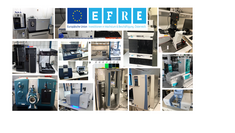ERDF InfraCore: High End Bioanalysis Infrastructure
To strengthen the University of Natural Resources and Life Sciences (BOKU) Core Facilities (CFs) "Bioactive Molecules: Screening and Analysis" (BMOSA) and "Analysis of Lignocellulosics" (ALICE) at the Tulln site, the ERDF REACT project for the establishment of a high-performance infrastructure for the analysis of bioactive substances and renewable raw materials (InfraCore) WST3-F-5031245/007-2021 was realized within the framework of the REACT-EU initiative. The acquisition of new high-performance infrastructure was carried out in cooperation with the province of Lower Austria (Lower Austrian Economy and Tourism Fund). The application was coordinated by the head of the Institute of Bioanalytics at BOKU-Department IFA-Tulln, Univ.Prof. Rudolf Krska.
The acquisitions in the area of instrumental analysis are intended to ensure that the two CFs at the Tulln site can also be operated in accordance with the latest state of the art in the future. In this way, access to the most modern large-scale equipment infrastructure can be guaranteed for a wide range of users in the coming years, both within BOKU and for third parties. The planned investments should ensure the continuous further development of the respective work and research areas of BOKU and its partners in Tulln and thus strengthen the Campus Technopol in the long term.
BOKU has created a total of eight CFs in the last three years (https://boku.ac.at/cf). These new organizational units bundle cost- and support-intensive infrastructure with the aim of facilitating access to the existing large-scale equipment and promoting both scientific excellence and research cooperation. Two of these newly established CFs are located at the Tulln site and are associated to four BOKU institutes. The CF BMoSA focuses on high-throughput screening for the discovery of new bioactive substances (Institute for Microbial Genetics) and the comprehensive analysis of biological samples for their composition of metabolic products, contaminants and polymers (Institute for Bioanalysis and Agro-Metabolomics and Institute for Environmental Biotechnology at BOKU- Department IFA-Tulln) using mass spectrometry. CF ALICE is located at the Institute for Chemistry of Renewable Resources (ChRR) and deals with the analysis of renewable resources (focus on lignocellulose and biorefinery products) at the University and Research Center Tulln (UFT).
With an investment volume of approx. 2.4 million euros, the following devices were purchased and put into operation.
LC-HRMS Orbitrap (device 1) very high mass resolution, mass accuracy and detection sensitivity for the unbiased characterization of complex biological samples and the structural elucidation of the metabolites contained therein.
HPLC radioactivity detector (device 2) for determining the incorporation of radiotracers (mostly 14C) in biological systems as an important alternative to also detect insoluble substances.
UHPLC-MS/MS system (device 3a,3b)
The CF BMoSA did not previously have a triple quadrupole tandem mass spectrometer for accurate, sensitive and targeted small molecule quantification. The spectrometer is coupled to a UHPLC system
HPTLC system (device 4) enables automated sample analysis using high-performance thin-layer chromatography
Photoacoustic near-infrared / mid-infrared spectrometer (PA NIR/MIR FTIR) (device 5) for the development and application of rapid methods for the analysis of feed and food samples for their mycotoxin content.
Automated combined incubation readout system (device 6a, 6b) for a robotic system for pick and place tasks and data integration for high-throughput analysis of bioactive substances and enzymes and for screening of strain collections and reporter organisms.
Confocal laser scanning microscope (device 7a, 7b) for quantitative microscopy for e.g. reporter assays, fungal strain development and as a scientific service at the Tulln campus.
ATR FTIR (device 8) for infrared spectroscopy, primarily used for the analysis of cellulose-containing materials and lignin products
Ion chromatography (IC) (device 9) for analysis of mono- and oligosaccharides after ion complexation.
GC pyrolysis detector (device 10) for the pyrolysis (thermal decomposition) of lignocelluloses in order to be able to characterize them chemically by gas chromatography.
2D-SEC (device 11) allows two-dimensional size exclusion chromatography (SEC) for the analysis of lignin.
The purchased devices and the associated services are only accessible to internal and external users within the framework of the BOKU Core Facilities ALICE and BMoSA. The centralized use of infrastructure results in various advantages. Optimal maintenance and servicing by specialized CF staff as well as support for users with the appropriate technical expertise to ensure optimal research results. In addition, the utilization of the devices can be economically optimized by operating them within the CFs. One of the primary goals of the BOKU Core Facilities is to guarantee user-friendliness. This is guaranteed, among other things, by comprehensive descriptions and useful information about the equipment on the respective websites of the core facilities (https://boku.ac.at/cf/bmosa; https://boku.ac.at/cf/alice). In addition, the devices were included in the BMBWF database (https://forschungsinstrumente.bmbwf.gv.at/de).

